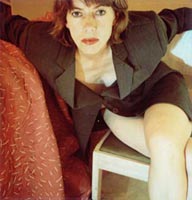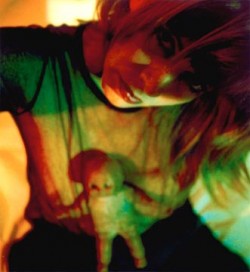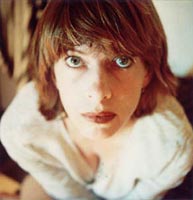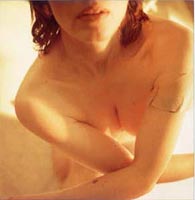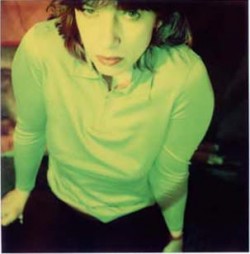|
Biography
1953
Toto Frima is born in The Hague as the second child in a family with three girls and one boy. She grows up in Zoetermeer.
1979
Toto makes her first pictures, selfportraits, often with an emotional and erotic touch. In this initial period she is strongly encouraged by Manfred Heiting, at that time the Director of Polaroid Creative Design Europe. He keenly follows her artistic development and supports her by letting her dispose of working material and by buying photographs. This way Toto’s very first SX70 Polaroid photographs go directly to the Polaroid Collection.
1980
After Toto Frima’s first exhibition, the group exhibition: ‘Instantanées’ (with a catalogue) in the Centre Pompidou, she finds herself right in the heart of the world of accepted photography. The Centre Pompidou takes two pictures in its collection.
1981
Toto lives in Brussels for one year and afterwards she lives for one year in a row with her mother in a village in the Betuwe, on the (Dutch) countryside. She uses this period for experimenting with her polaroid camera. She likes this way of working so much that she continues making polaroids for the rest of her career. Because the result of the photograph is immediately to be seen during the working process, she can adapt the next pictures, so that they correspond with her mood of the moment. She takes many photographs, at first all single ones. Once movement blurring comes into her work, she starts making series, a.o. in order to emphasize that her pictures do not occur accidentally, but are, on the contrary, carefully directed.
1982
For the second time Toto Frima takes part in a group exhibition in the Centre Pompidou. It is called: ‘Les autoportraits de photographes’ (with a catalogue). On the last day of the exhibition some of her work is stolen.
1983
Toto moves to Amsterdam. In this year she has her first solo exhibition in the Centre Pompidou. (Musée National d’Art Moderne, Paris). Here she shows series of seven SX70 polaroids. At first sight the seven polaroids appear to be identical, but there is a slight difference in every picture, so that the photographs reinforce each other.
1985
Toto’s work changes, she now takes photographs of parts of the body, whereby the series shows the body as a whole. The shape is changing, but the subject, “the self-image” becomes more and more outspoken. These photographs are the starting point for a number of ciba-chromes that are shown in the Canon Image Centre in Amsterdam.
After a number of series of 3, 4 and five parts, Toto photographs herself more and more often in a series of only two images. These dypticks later serve as preparatory studies for the next work by Toto Frima: the 50×60 (cm) Polaroids. The small SX70 photographs often resulted in intimate and suggestive images, for the 50×60 photographs this is, because of the size and the studio character of the work, not so well possible. In the basement of the Centre Pompidou Toto Frima was offered the first opportunity to work with this 50×60 Polaroid camera. A number of the photographs that were made here, are later shown in the Centre Pompidou in the group exhibition ‘Atelier Polaroid’ (with a catalogue). Using this polaroid camera is just the right thing for Toto: between 1985 and 1990 Toto often travels to Frankfurt am Main, in Germany, in order to work with this camera regularly. In this period Toto also starts working with black/white – Polaroid black/white pos/neg film. In the first year she is assisted by a male friend, later she works again all by herself, like always.
1987
The photo magazine ‘Foto’ publishes a portfolio with her first large Polaroids and her first black/white work: ‘Toto Frima een vrouw met zichzelf’ (transl.: Toto Frima, a woman with herself).
1988
The “Rijksdienst Beeldende Kunst” (national service for plastic arts) buys a 50×60 Polaroid.
1990
Toto has a large solo exhibition in the “Rheinisches Landes Museum” in Bonn. At the same time a book is published which is titled: ‘Toto Frima 50×60’. The book, hardcover, sixty color pictures, has a foreword by professor Klaus Honnef, the curator of the exhibiton in Bonn. Beside a Dutch edition, there also is an English and a German edition by the Nishen Verlag, Berlin and London. After Bonn, the 50×60 exhibition goes to the Musée de la photographie in Charlerois, Belgium, the Liberia Maeght in Barcelona, the university of Valencia, Spain, and “de Meervaart” in Amsterdam.
1993
The Polaroid Collection is dissolved and the art work is distributed. Toto Frima’s work goes to the “Maison Europčenne de la Photographie, Ville de Paris”.
1994-1997
Re-orientation on her own work and life. Toto is educated to be a social worker and she has several jobs in the field of assistance and care for elderly people.
1998
After a period of almost 5 years without self-images, Toto Frima starts again to make her small SX70 polaroids. The polaroid SX70 material she knows so well now is the basis for scans and prints. After a long period of silence, Toto exhibits a series of Lambda’s in “De Melkweg” in Amsterdam.
1999
She also starts working again with the large camera, which has meanwhile been moved from Frankfurt am Main to Prague. Several exhibitions of new work follow: scans of her SX70, lambda’s and 24×24″ material. The work Toto shows now has evolved, it has become more sober and voyeuristic elements have consciously been banished.
2000
Exhibitions with new work in Zaragoza, Spain and Vlaardingen, Netherlands.Toto is invited by Polaroid to work with the 20×24″ camera at the Photokina Cologne, she continues her new series of close-up portraits. A new cooperation is started with different galleries: Parade in Amsterdam, Zero Infiniti at Besancon, 51 fine art phography at Antwerpen and Pons & Schmid at Brussels.
Toto Frima – Exhibitions Overview
solo tentoonstellingen
2000
SPECTRUM, Zaragoza Spanje
KUNSTHANDEL PARADE, Amsterdam, NL
GALERIE IN BEELD, Vlaardingen, NL
Hopper2 Cologne, Keulen, Duitsland
1999
MELKWEG, cafe restaurant: de zwarte muur, Amsterdam, NL
HET PALEIS, cafe, Amsterdam, NL
PHERMADOCUMENT, Brussel, Belgie
MAGICMINDS, Amsterdam, NL
CHATEAU LA CHOQUELLE Dunekerque, Frankrijk
1997
IM FOCUS, GALERIE AM DOM Burckhard Arnold, Keulen, Duitsland
1995
GALLERIE Leiden, NL
1994
MUSEO KEN DAMY
PICTURE ME BLUE Melkweg Amsterdam, NL
GALERIA SPECTRUM Zaragoza, Spanje
IM KABINET GALERIE Berlijn, Duitsland
groepstentoonstellingen
2000
“VALENTINE EROTIC ART SHOW”, Kunsthandel Parade Amsterdam.
LA COLLECTIONS 10 ANS DE GALERIE LE LIEU, Lorient, Frankijk
VLAAMS MUSEUM VOOR FOTOGRAFIE, Antwerpen, Collectie Bert Hartkamp
PARIS PHOTO Salon internatoinal de la photgraphie: Galerie Zero l’Infiniti, Besancon, Frankrijk
1999
DARRY HELLEBUYCK – 19 impressies van een man, Kunstacademie, Belgie
1998
LUDWIG MUSEUM “Zartlichen Betrachtung Schöner Damen” Keulen Duitsland.
L. FRITZ GRUBER: Eine Fotografische Hommage zum 90. geburtstag, Lichtblick Galerie, Keulen, Duitsland
L. FRITZ GRUBER: Eine Fotografische Hommage zum 90. gebrutstag; Hotel Hopper Keulen, Duitsland.
PARIS PHOTO, Salon international de la photographie: Spectrum , (Zaragoza, Spanje)
PARIS PHOTO, Salon international de la photographie: Fotografieforum International, (Frankfurt, Duitsland)
|
|


